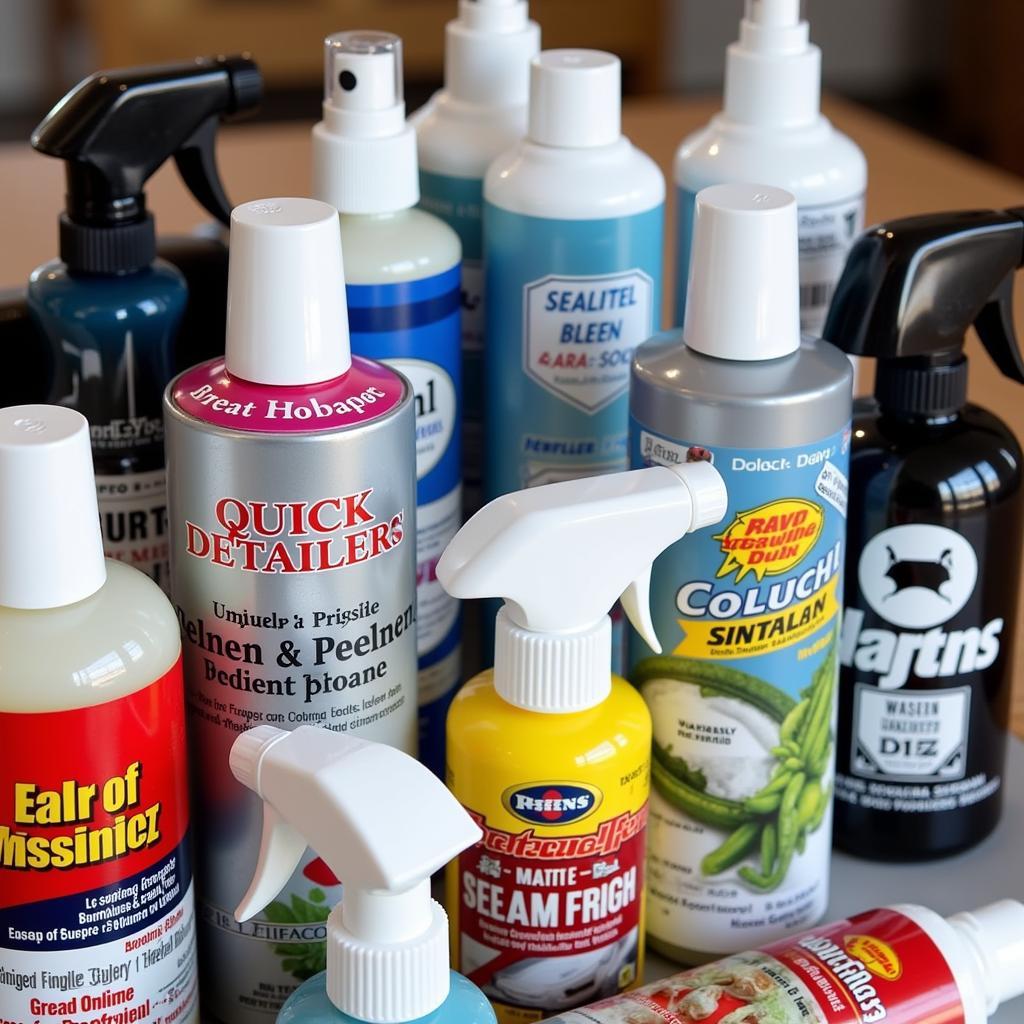Car detailing spray is a staple in any car enthusiast’s arsenal. But what’s actually in that bottle you’re spraying on your prized possession? Understanding the ingredients in your car detailing spray is crucial for achieving the desired results and, more importantly, avoiding potential damage to your vehicle’s finish. This article delves into the composition of various car detailing sprays, shedding light on their functions and benefits.
Unmasking the Ingredients: A Deep Dive into Car Detailing Spray Formulas
Different types of car detailing sprays cater to specific needs, from enhancing shine to protecting against environmental contaminants. Let’s break down the common components you’ll find:
The Foundation: Carriers and Solvents
- Water: The most common carrier, water dilutes the concentrated ingredients and allows for even application.
- Solvents: These help dissolve and lift away dirt, grime, and other residues. Common solvents include isopropyl alcohol and various glycol ethers. These solvents are vital for effective cleaning but should be used with caution as excessive use can strip waxes or sealants.
 Car Detailing Spray Ingredients
Car Detailing Spray Ingredients
The Cleaners: Surfactants and Detergents
- Surfactants: These are the workhorses of car detailing sprays, reducing surface tension and allowing water to penetrate and lift dirt particles. They encapsulate the dirt, allowing it to be rinsed or wiped away.
- Detergents: These provide extra cleaning power, especially for stubborn grease and grime. However, harsh detergents can strip waxes, so opt for pH-neutral formulas for regular use.
The Shiners: Polymers and Silicones
- Polymers: These create a protective layer on the car’s surface, adding shine and enhancing the depth of color. They also help repel water and contaminants.
- Silicones: Similar to polymers, silicones provide a glossy finish and offer water-beading properties. Some silicones offer UV protection, guarding against sun damage.
The Protectors: UV Inhibitors and Wax
- UV Inhibitors: These shield your car’s paint from harmful UV rays, preventing fading and oxidation.
- Wax (Carnauba or Synthetic): While not present in all detailing sprays, some quick detailers or spray waxes incorporate wax for added protection and shine. This offers a boost of hydrophobic properties, repelling water and preventing water spots.
Other Additives: Fragrances and Preservatives
- Fragrances: These add a pleasant scent to the spray, masking any chemical odors.
- Preservatives: These extend the shelf life of the product.
What Temperature to Clay Car Detailing? Ensuring Optimal Results
Temperature plays a crucial role in the effectiveness of many car detailing products, including clay bars. You might be wondering about the ideal temperature for claying. Check out our article what temperature to clay car detailing for a comprehensive guide.
Decoding the Label: Understanding Product Claims
Car detailing spray labels can be confusing. Look for keywords like “pH-neutral,” “wax-safe,” or “ceramic-infused” to understand the product’s properties.
“A high-quality car detailing spray should not only clean but also protect,” says renowned detailing expert, David Miller, founder of Miller’s Mobile Detailing. “Look for formulas that offer UV protection and polymer or silicone-based shine enhancers.”
How to Detail the Interior of a Car? A Step-by-Step Guide
While exterior detailing is important, don’t neglect the interior. Learn how to detail your car’s interior with our comprehensive guide: how to detail your car’s interior.
Conclusion: Choosing the Right Spray for Your Needs
Knowing what’s in your car detailing spray empowers you to make informed decisions. By understanding the ingredients and their functions, you can select the right product for your car’s specific needs, ensuring a stunning shine and long-lasting protection. Remember to always test a small, inconspicuous area first before applying any new product to your entire car.
FAQs
- Can I use car detailing spray on all exterior surfaces?
- How often should I use car detailing spray?
- Can I use car detailing spray in direct sunlight?
- What’s the difference between a quick detailer and a waterless wash?
- How do I remove streaks or residue left by car detailing spray?
- Is it safe to use car detailing spray on tinted windows?
- Can I use car detailing spray on vinyl wraps or matte paint?
For those dealing with a flooded car, our guide on how to flood dry a car detailing offers valuable advice. Alternatively, explore our article on how to stay dry when detailing cars for tips on staying protected during the detailing process. And for a deeper dive into car interior detailing, refer to how to detail the iterious of a car.
Need help with your car detailing needs? Contact us via WhatsApp: +1(641)206-8880 or email us at [email protected]. We have a 24/7 customer support team ready to assist you.

Leave a Reply